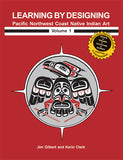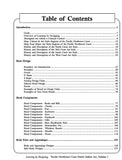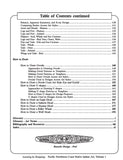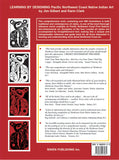By Jim Gilbert and Karin Clark
🎉NEW LOWER PRICE $27.95 (was $34.95)
Your essential guide to complex and easy First Nations art designs in Pacific Northwest Coast style
Learning by Designing Pacific Northwest Coast Native Indian Art: Volume 1, by Jim Gilbert and Karin Clark, is your comprehensive guidebook to Pacific Northwest Coast Native art designs.
You’ll find 800 detailed native-art-style illustrations in this book, including both complex and easy First Nations Native art, so you can learn or teach the artform at different levels of expertise.
This book makes Pacific Northwest Coast Native art designs easy and approachable through culturally accurate, respectful content.
There are hundreds of examples of diverse Pacific Northwest Coast First Nations and Native American animal art designs in this guidebook.
Start with easy First Nations art basics, then graduate to more complex Pacific Northwest Coast Native art designs, all in one book.
Enjoy hundreds of Indigenous animal art designs at your fingertips.
You’ll have a myriad of Pacific Northwest Coast Native American animal art within arm’s reach and easily searchable in the book’s extensive index.
Find Native eagle art, Native bear art, Native American mythical creatures, Native orca art, Native salmon art, Native hummingbird art, and Native butterfly art, Native crow art, and many other creatures common to different indigenous cultural regions on the Pacific Northwest Coast.
You’ll learn Pacific Northwest Coast Native art design, step-by-step, with this comprehensive guidebook, including "how to draw" sections.
- Simplify Native art designs with step-by-step, clear, concise directions and detailed illustrations.
- Create meaningful, original Native art designs in Pacific Northwest Coast styles.
- Save hours of researching Native art designs online with well-researched cultural background information and regional art-style comparisons.
- Beginner to expert, find Native art designs for everyone!
- Meet your curriculum expectations beautifully, with history and applied Native art design techniques, if you're a teacher or homeschooler.
- Feel confident in respectful content. Our books have been vetted and recommended for accuracy and respectful tone by First Nations artists, educators, and community members.
More about Volume 1:
- A reference and instruction manual with a detailed, thoroughly analyzed, well-supported comparison of four Pacific Northwest Coast Native art design styles.
- Includes 800 clear, detailed illustrations accompanied by straightforward copy.
- Topics cover design formline, ovoids, U shapes, S shapes, heads, body parts, and design formation, as well as a step-by-step “how to draw” section.
- A glossary explains terms, an extensive index supplies easy references, and a bibliography supplies further resources.
- Durable soft cover, black and white, 224 pages.
- 5 in x 11 in
- First published 2000 and reprinted in 2002, 2005, and 2012, Volume 1 has sold over 25,000 copies to date, and it is one of our most popular books.
Don't forget to buy the companion manual
_____________________________________
Customer Reviews
“This book provides valuable information about the complex variations of Northwest Coast designs. It is well researched, and all artists should benefit from this information. I HIGHLY RECOMMEND THIS BOOK. Congratulations.” — Chief Tony Hunt Mupin Kim, Klah Kwa Tzee Four Times Chief/Big Copper - Kwagulth Master Carver and Artist. Tsaxis/Victoria, B.C.
“This well researched and richly illustrated book will be of great benefit to anyone, from children to adults, who wants to learn about the art styles of Northwest Coast First Nations."— Steve Brown, Author and Artist, Associate Curator, Native American Art, Seattle Art Museum. Seattle, Washington.
“An incredible teaching resource that can be integrated into the curriculum for the teaching of art in a comprehensive manner ... will provide a bridge of understanding to the diversity of the art styles of the Northwest Coast." — Nella Nelson, First Nations Education Division Coordinator, Greater Victoria School District, Member of the Tsawataineuk Band, Kwakwaka’wakw Nation. Victoria, B.C.
“A font of information for those who feel a need to understand more about the fascinating complexities of Northwest Coast Native Indian Art ... Excellent, the best yet." — Reg Ashwell, Art Collector, Consultant and Author. Saltspring Island, B.C.
_____________________________________
Table of Contents
Introduction
Goals
Overview of Learning by Design
Aboriginal Art within a Cultural Context
Map: Culture and Art Style Regions of the Pacific Northwest Coast
Map: Four Major Art Style Regions of the Pacific Northwest Coast
History and Description of the Mid Coast Art Style
History and Description of the South Coast Art style
History and Description of the West Coast Art Style
Basic Design
Formline: An Introduction
Formline
Ovoid
U Shape
S Shape
Joining Design Units
Salmon Head Design
Heads
Examples of Heads in Design Units
Examples of Free Form Heads
Head Components
Beaks and Bills
Cheeks
Ears
Eyebrows
Eyes
Foreheads
Gills
Hats, Headbands, Hair
Moustaches, Beards
Mouths
Noses
Body Parts and Appendages
Body and Appendage Designs
Split Body Designs
Balance, Apparent Symmetry, and X-Ray Design
Comparing Bodies Across Art Styles
Arms and Hands - Human
Legs and Feet - Bird Toes, Claws, Webs
Fins and Tails - Fish and Sea Creature
Tails - Otter
Tails - Whales
Tails - Animal
Wings and Tails - Bird
How to Draw
How to Draw Ovoids
Approaches to Drawing Ovoids
Making Ovoid Patterns or Templates
How to Draw Ovoids Across Art Styles
Ovoids Used in Designs Across art Styles
How to Draw a North Coast Art Style Eye and Eyelid
How to Draw U Shapes
Approaches to Drawing U Shapes
Making U Shaped Patterns or Templates
How to Draw U Shapes for Design Purposes
U Shapes Used in Designs Across Art Styles
How to Draw an Eagle Head
How to Draw a Salmon Head
How to Draw a Human Head
How to Draw a Killer Whale
How to Draw a Wolf Head
Glossary
Glossary of Art Terms
Bibliography and Resources
Index








